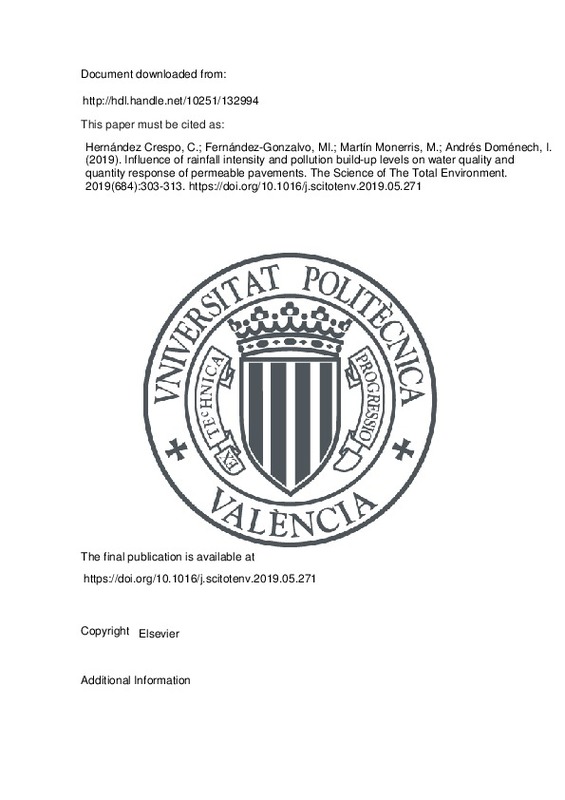JavaScript is disabled for your browser. Some features of this site may not work without it.
Buscar en RiuNet
Listar
Mi cuenta
Estadísticas
Ayuda RiuNet
Admin. UPV
Influence of rainfall intensity and pollution build-up levels on water quality and quantity response of permeable pavements
Mostrar el registro sencillo del ítem
Ficheros en el ítem
| dc.contributor.author | Hernández Crespo, Carmen
|
es_ES |
| dc.contributor.author | Fernández-Gonzalvo, Miriam Inmaculada
|
es_ES |
| dc.contributor.author | Martín Monerris, Miguel
|
es_ES |
| dc.contributor.author | Andrés Doménech, Ignacio
|
es_ES |
| dc.date.accessioned | 2019-12-15T21:00:48Z | |
| dc.date.available | 2019-12-15T21:00:48Z | |
| dc.date.issued | 2019 | es_ES |
| dc.identifier.issn | 0048-9697 | es_ES |
| dc.identifier.uri | http://hdl.handle.net/10251/132994 | |
| dc.description.abstract | [EN] Permeable pavements are part of stormwater management practices known as sustainable urban drainage systems (SUDS). This study describes the influence of several environmental variables, such as the rainfall regime or the pollution build-up level, on the hydraulic and water quality performance of permeable pavements. Four infiltrometers with different configurations of pavement layers were used to study the influence of two rainfall regimes (Atlantic and Mediterranean) and two rainfall intensities (0.5 and 2.2 nn/min). The influence of the progressive pollution build-up level was studied by dry sprinkling of road deposited sediments collected with a mechanical street sweeper with a dose of 5 g/m(2)/d. The results show that permeable pavements retained a significant rainwater volume and improved the infiltrated water quality in terms of suspended solids, organic matter and nutrients when compared to the corresponding surface runoff potentially generated from an impervious pavement. The volume of rainwater retained inside them varied between 16 and 66% depending on the variables studied. The water infiltrated from permeable pavements subjected to a Mediterranean rainfall regime contained, in general, higher concentrations of organic matter (22 to 89 mg Chemical Oxygen Demand/l) and nutrients (0.6 to 2.1 mg Total Nitrogen/l and 0.05 to 045 mg Total Phosphorus/l) than those under Atlantic regime. However, the latter infiltrated higher loadings in terms of mass. Nitrogen was the substance that infiltrated the most, reaching a 25% of the total mass of nitrogen deposited on the pavements surface. The concentration and mass loading in infiltrated water increased as the pollution build-up level did. The leachability of nutrients and organic matter was greater for high rainfall intensities. The results suggest that it is essential to carry out an adequate cleaning in dry conditions, especially when high intensity rainfall events are foreseen, because of its greater capacity to mobilize pollutants. | es_ES |
| dc.description.sponsorship | This research was funded through the SUPRIS-SUPeI (Ref. BIA201565240-C2-2-R MINECO/ERDF, UE), financed by the Spanish Ministry of Economy and Competitiveness and the European Regional Development Fund (ERDF). Miriam Fernandez-Gonzalvo has a pre-doctoral contract funded by Generalitat Valenciana within the framework of the Program for the promotion of scientific research, technological development and innovation in the Valencian Community (ACIF/2018/111-FSECV 2014-2020). Authors would like to thank the manufacturer QUADRO for yielding paving stones and information on their composition for the research. | es_ES |
| dc.language | Inglés | es_ES |
| dc.publisher | Elsevier | es_ES |
| dc.relation.ispartof | The Science of The Total Environment | es_ES |
| dc.rights | Reserva de todos los derechos | es_ES |
| dc.subject | Permeable pavement | es_ES |
| dc.subject | Road deposited sediments | es_ES |
| dc.subject | Deposition rate | es_ES |
| dc.subject | Metals | es_ES |
| dc.subject | Leachability | es_ES |
| dc.subject.classification | INGENIERIA HIDRAULICA | es_ES |
| dc.subject.classification | TECNOLOGIA DEL MEDIO AMBIENTE | es_ES |
| dc.title | Influence of rainfall intensity and pollution build-up levels on water quality and quantity response of permeable pavements | es_ES |
| dc.type | Artículo | es_ES |
| dc.identifier.doi | 10.1016/j.scitotenv.2019.05.271 | es_ES |
| dc.relation.projectID | info:eu-repo/grantAgreement/MINECO//BIA2015-65240-C2-2-R/ES/SUPERFICIES URBANAS PERMEABLES E INTELIGENTES/ | es_ES |
| dc.relation.projectID | info:eu-repo/grantAgreement/GVA//ACIF%2F2018%2F111/ | es_ES |
| dc.rights.accessRights | Abierto | es_ES |
| dc.contributor.affiliation | Universitat Politècnica de València. Instituto Universitario de Ingeniería del Agua y del Medio Ambiente - Institut Universitari d'Enginyeria de l'Aigua i Medi Ambient | es_ES |
| dc.contributor.affiliation | Universitat Politècnica de València. Departamento de Ingeniería Hidráulica y Medio Ambiente - Departament d'Enginyeria Hidràulica i Medi Ambient | es_ES |
| dc.description.bibliographicCitation | Hernández Crespo, C.; Fernández-Gonzalvo, MI.; Martín Monerris, M.; Andrés Doménech, I. (2019). Influence of rainfall intensity and pollution build-up levels on water quality and quantity response of permeable pavements. The Science of The Total Environment. 2019(684):303-313. https://doi.org/10.1016/j.scitotenv.2019.05.271 | es_ES |
| dc.description.accrualMethod | S | es_ES |
| dc.relation.publisherversion | https://doi.org/10.1016/j.scitotenv.2019.05.271 | es_ES |
| dc.description.upvformatpinicio | 303 | es_ES |
| dc.description.upvformatpfin | 313 | es_ES |
| dc.type.version | info:eu-repo/semantics/publishedVersion | es_ES |
| dc.description.volume | 2019 | es_ES |
| dc.description.issue | 684 | es_ES |
| dc.relation.pasarela | S\396545 | es_ES |
| dc.contributor.funder | Generalitat Valenciana | es_ES |
| dc.contributor.funder | Ministerio de Economía y Competitividad | es_ES |







![[Cerrado]](/themes/UPV/images/candado.png)

